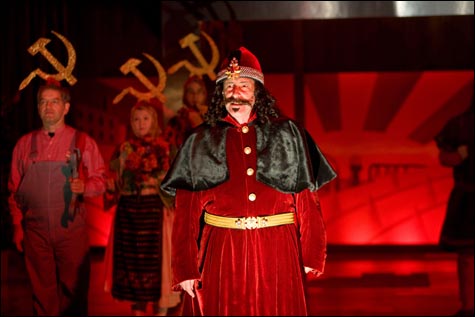
THE COMMUNIST DRACULA PAGEANT: The greater point would seem to be that history is as much theater as theater is. |
There is more pageantry than either Stalinism or Stoker in The Communist Dracula Pageant, Anne Washburn’s ambitious jumble of a Romanian-history play now in its world premiere from the American Repertory Theatre (at Zero Arrow Theatre through November 9). Taking its cue from the self-deluded dictatorship of Communist-nationalist strongman Nicolae Ceausescu, which ended in December of 1989 faster than you could do your Christmas shopping, and reaching back to the 15th-century reign of the real Dracula, Vlad Tepes, the play is a grotesque meditation on the march and media manipulation — from Gutenberg to television — of history.The complete, longwinded if whimsical title is The Communist Dracula Pageant by Americans, for Americans, a play about the Romanian Revolution of 1989 with hallucinations, phosphorescence, and bears — which underlines the far-ranging intent of this sinister satire of the political rewriting of the national script. But its best parts riff on the cheesy, propagandistic pageants favored by Ceausescu and his wife, Elena, at the height of their power. After a brief opening gambit lifted from the pair’s kangaroo-trial transcript, the play jumps back to 1976 to imagine such a spectacle, in which a glamorized, intellectualized version of Elena (who painted herself a scientist despite a fourth-grade education) celebrates the 500th anniversary of the death of Tepes, who quickly gets into the act, strutting in velvet robes and a bejeweled cap.

Tepes, despite his nasty habit of skewering citizens on sticks, is considered a national hero in Romania for his actions against the Turks. And in the Captain Hook–esque figure of Will LeBow, he delivers a message both ghoulish and seductive, in which national identity is a skein of pride and ruthlessness, history a mesh of rumor, imagination, manipulation, and fact. This conjured Tepes is joined in the play’s flag-waving celebration of Ceausescu-esque aggrandizement and Romanian lore by robotic “pageanteers” in coveralls, folk costume, hammer-and-sickle headdresses, and military uniform, all singing the praises of “Dracula, a man . . . sinisteracula, simicuracula, perhapula.” Finally, this messenger from history looks up into the grid of lights and is surprised to find written in the stars the name CEAUSESCU.
But much of Washburn’s Pageant — which is directed by Obie winner Anne Kauffman in such a way as to put us both before it and in the wings — is more Brechtian than Busby Berkeleyan. In a note to the text, the author observes: “More of this play is fact or factually based than is plausible.” Indeed, huge hunks are taken from the trial transcript, sometimes sliced and diced, in which the couple, seriously disconnected from reality if not from personal mythology, refused to acknowledge the authority of the tribunal that condemned them to death (for crimes ranging from genocide to living high while the Romanian people lacked electricity) and then promptly had them shot. Other scenes and speeches derive from found footage on YouTube.
Lest you think docudrama rather than fantasia, I should mention the bear: a chubby, shambling, caramel-colored creature that comes ambling on to gorge on the pot of honey Tepes has slunk on stage bearing. Pawing the stuff into its gaping mouth (at the back of which lurks the face of Remo Airaldi), the animal becomes drunk or dazed; it falls; then it gets shot. Did Ceausescu (who fancied himself a hunter) shoot it? Is it Russia? And what is the significance of the dance at the end of the play in which the participants wear bits and pieces of the bear costume?
Got me. But the greater point would seem to be that history is as much theater as theater is. Many events of the play do not so much unfold as get staged. It’s when you lose control of the puppet strings — as Ceausescu and the lackey/spy known as the Functionary do when they try to manipulate the reactions of an unruly crowd to a speech by the leader — that you’re in trouble. Some of The Communist Dracula Pageant takes place simultaneously on stage and on video screens hung above it. Cameras are pushed on to record events, and in one long scene involving video technicians, a brutal event is invented.
Washburn’s bag of tricks is intellectually fascinating, but it’s a mixed bag. Too many of the proceedings — played out against little more than a few red flats, the TV screens, and a potted plant — are either cryptic or confusing. Even an educated Cambridge audience, familiar with the Romanian coup/revolution of ’89, won’t know all the players, some of whom seem interchangeable. It is implied toward the end that Ceausescu didn’t live long enough to meet the firing squad but that the show had to go on. Is this Washburn’s invention, in keeping with her theme?